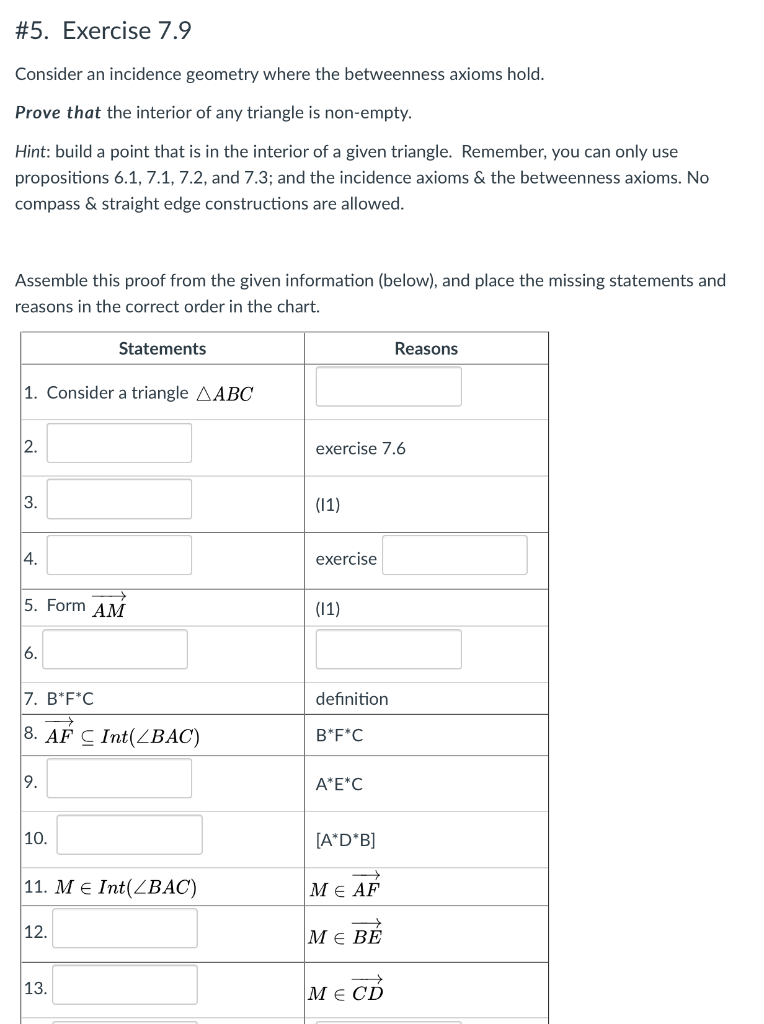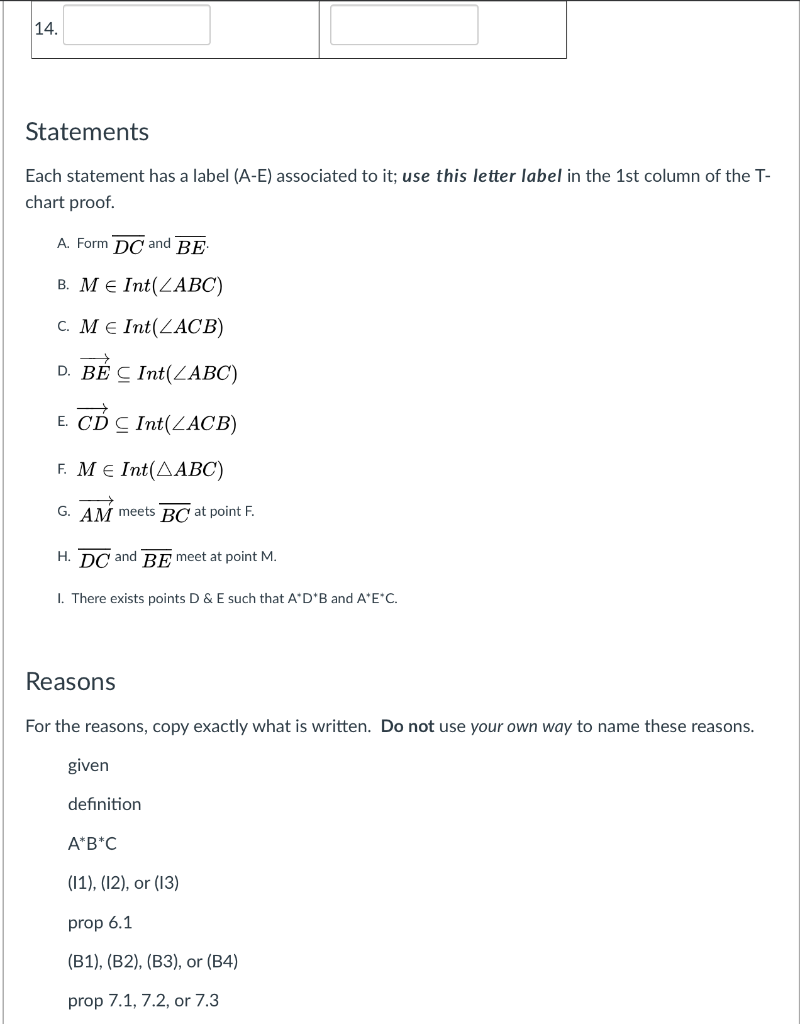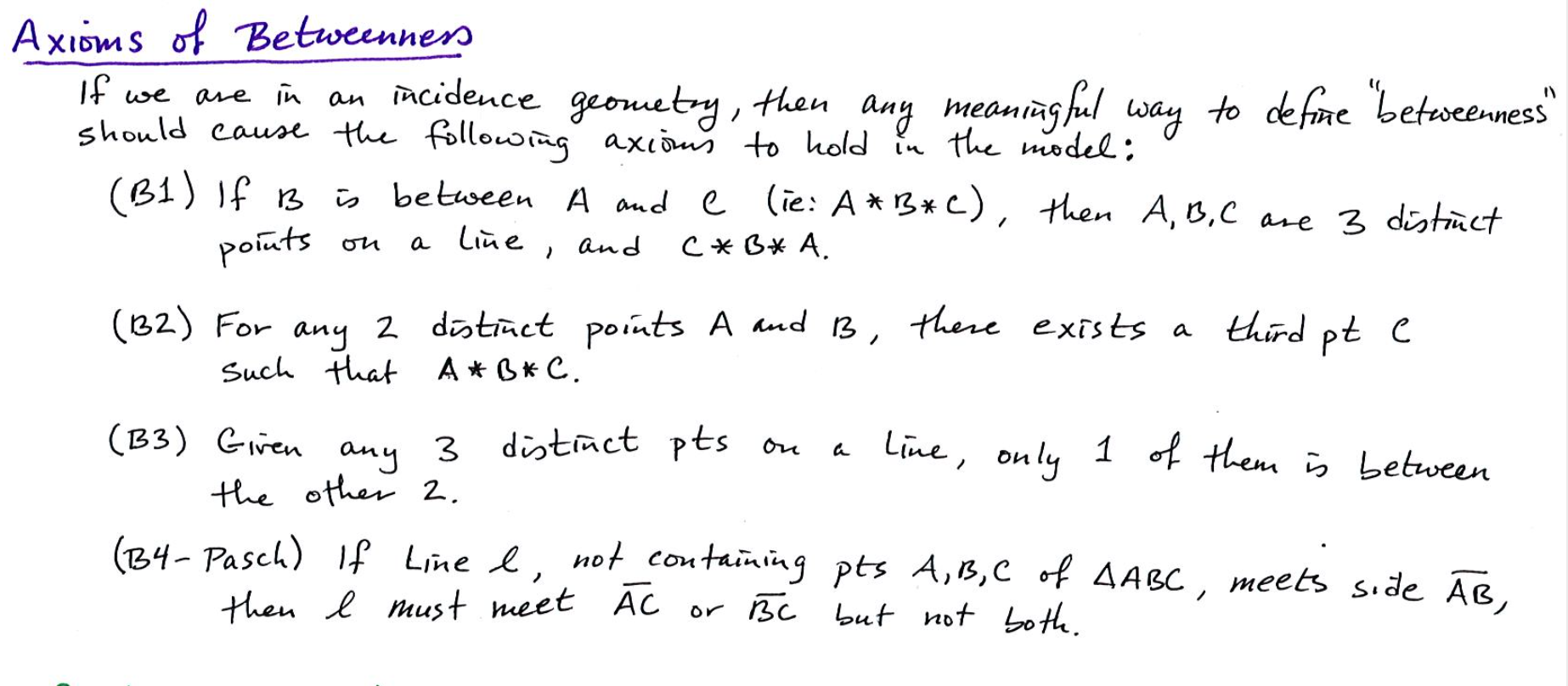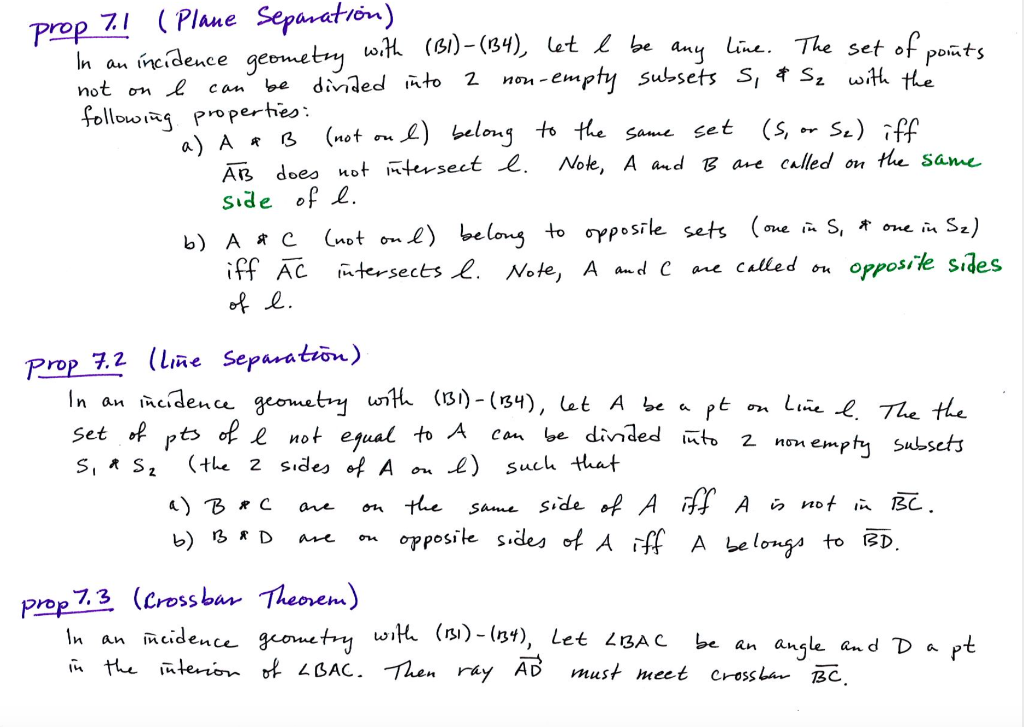NEED #5 Exercise 7.9 The axioms and all give al the way at the bottom





#5. Exercise 7.9 Consider an incidence geometry where the betweenness axioms hold. Prove that the interior of any triangle is non-empty. Hint: build a point that is in the interior of a given triangle. Remember, you can only use propositions 6.1, 7.1, 7.2, and 7.3; and the incidence axioms & the betweenness axioms. No compass & straight edge constructions are allowed. Assemble this proof from the given information (below), and place the missing statements and reasons in the correct order in the chart. Statements Reasons 1. Consider a triangle ABC 2. exercise 7.6 3. (11) 4. exercise 5. Form AM (11) 6. 7. B*F*C definition 8. AF C Int(ZBAC) B*F*C 9. A*E*C 10. [A*D*B] 11. M e Int(ZBAC) ME AF 12. ME BE 13. . M 6 CD 14. Statements Each statement has a label (A-E) associated to it; use this letter label in the 1st column of the T- chart proof. A. Form DC and BE B. M e Int(ZABC) C. M e Int(ZACB) D. B C Int(ZABC) E. CDC Int(ZACB) F. Me Int(ABC) G. AM meets BC at point F. H. DC and BE meet at point M. 1. There exists points D & E such that A *D*B and A*E*C. Reasons For the reasons, copy exactly what is written. Do not use your own way to name these reasons. given definition A*B*C (11), (12), or (13) prop 6.1 (B1), (B2), (B3), or (B4) prop 7.1, 7.2, or 7.3 Axioms of Betweenness If we are in an incidence Geometry, then any meaningful way to define betweenness" should cause the following axious to hold in the model: (B1) if B is between A and e (ie: A*B*C), then A, B, C are 3 distinct points on a line and (32) For any 2 distinct points A and B, there exists a third pt e such that A*B*C. C*B* A. a live, only (B3) Giren 3 distinct pts on any 1 of them is between the other 2. (34- Pasch) If Line e, not_containing pts A,B,C of 4ABC, meets side B, then must meet o or bc but not both. Incidence Axioms (II) For . 2 distinct pts, there exists a unique line containing them. any (12) Every Line contains at least 2 pts. (13) There exists 3 noncollinear points in the geometry. Prop 6.1 Two distinct lines can have at most 1 point in common in an incidence incidence geometry. can prop 7.1 (Plaue Separation) In an incidence geometry with (B1) (134), let l be any line. The set of not on l be divided into 2 on-empty subsets S, & S with the points following properties: a) A AB (not l) belong to the same set (s, or Se) iff AB does not intersect e. Note, A and B are called on the same side of l. b) A & C (not onl) belong to opposite sets (one in S, & one in Sz) intersects l. Note, A and C are called opposite sides of e. iff C OK prop 7.2 (Lie Separation) In an incidence geometry with (31)-(34), let A be a pt Line I. The the set of pts of l not equal to A can be divided into 2 non empty subsets S, as, (the 2 sides of A on e) such that a) Bac same side of A iff A is not in BC. b) BRD opposite sides of A iff A belongs to BD. prop 7.3 (crossbar Theorem) In an incidence geometry with (31)-(34), Let LBAC be an angle and D .pt in the interion of LBAC. Then ray AD must meet crossbar BC. on the ok #5. Exercise 7.9 Consider an incidence geometry where the betweenness axioms hold. Prove that the interior of any triangle is non-empty. Hint: build a point that is in the interior of a given triangle. Remember, you can only use propositions 6.1, 7.1, 7.2, and 7.3; and the incidence axioms & the betweenness axioms. No compass & straight edge constructions are allowed. Assemble this proof from the given information (below), and place the missing statements and reasons in the correct order in the chart. Statements Reasons 1. Consider a triangle ABC 2. exercise 7.6 3. (11) 4. exercise 5. Form AM (11) 6. 7. B*F*C definition 8. AF C Int(ZBAC) B*F*C 9. A*E*C 10. [A*D*B] 11. M e Int(ZBAC) ME AF 12. ME BE 13. . M 6 CD 14. Statements Each statement has a label (A-E) associated to it; use this letter label in the 1st column of the T- chart proof. A. Form DC and BE B. M e Int(ZABC) C. M e Int(ZACB) D. B C Int(ZABC) E. CDC Int(ZACB) F. Me Int(ABC) G. AM meets BC at point F. H. DC and BE meet at point M. 1. There exists points D & E such that A *D*B and A*E*C. Reasons For the reasons, copy exactly what is written. Do not use your own way to name these reasons. given definition A*B*C (11), (12), or (13) prop 6.1 (B1), (B2), (B3), or (B4) prop 7.1, 7.2, or 7.3 Axioms of Betweenness If we are in an incidence Geometry, then any meaningful way to define betweenness" should cause the following axious to hold in the model: (B1) if B is between A and e (ie: A*B*C), then A, B, C are 3 distinct points on a line and (32) For any 2 distinct points A and B, there exists a third pt e such that A*B*C. C*B* A. a live, only (B3) Giren 3 distinct pts on any 1 of them is between the other 2. (34- Pasch) If Line e, not_containing pts A,B,C of 4ABC, meets side B, then must meet o or bc but not both. Incidence Axioms (II) For . 2 distinct pts, there exists a unique line containing them. any (12) Every Line contains at least 2 pts. (13) There exists 3 noncollinear points in the geometry. Prop 6.1 Two distinct lines can have at most 1 point in common in an incidence incidence geometry. can prop 7.1 (Plaue Separation) In an incidence geometry with (B1) (134), let l be any line. The set of not on l be divided into 2 on-empty subsets S, & S with the points following properties: a) A AB (not l) belong to the same set (s, or Se) iff AB does not intersect e. Note, A and B are called on the same side of l. b) A & C (not onl) belong to opposite sets (one in S, & one in Sz) intersects l. Note, A and C are called opposite sides of e. iff C OK prop 7.2 (Lie Separation) In an incidence geometry with (31)-(34), let A be a pt Line I. The the set of pts of l not equal to A can be divided into 2 non empty subsets S, as, (the 2 sides of A on e) such that a) Bac same side of A iff A is not in BC. b) BRD opposite sides of A iff A belongs to BD. prop 7.3 (crossbar Theorem) In an incidence geometry with (31)-(34), Let LBAC be an angle and D .pt in the interion of LBAC. Then ray AD must meet crossbar BC. on the ok











